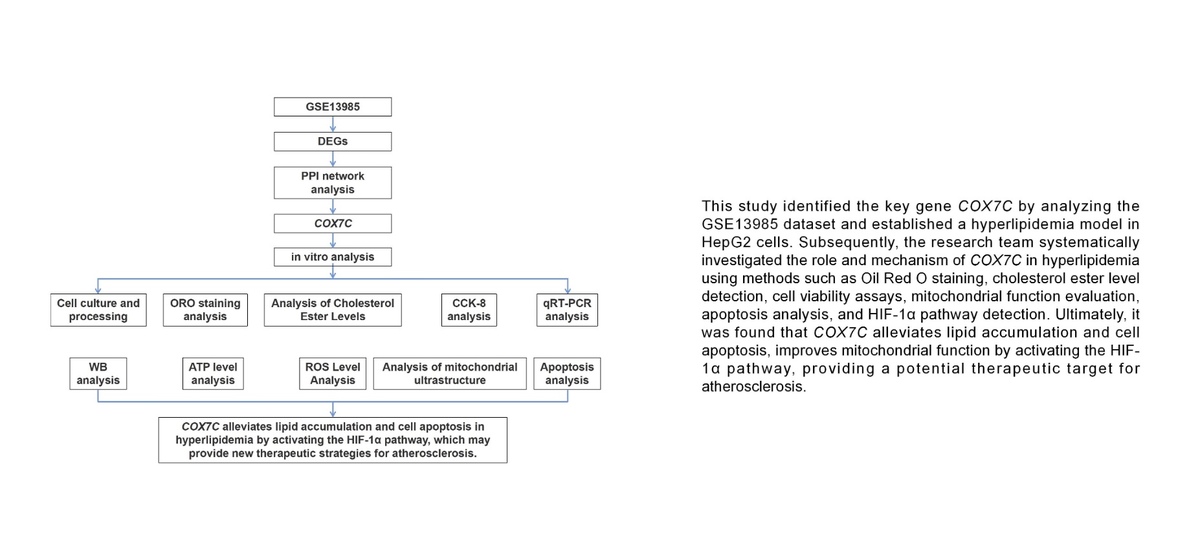Current issue
Archive
Manuscripts accepted
About the Journal
Editorial office
Editorial board
Section Editors
Abstracting and indexing
Subscription
Contact
Ethical standards and procedures
Most read articles
Instructions for authors
Article Processing Charge (APC)
Regulations of paying article processing charge (APC)
LIPID DISORDERS / RESEARCH PAPER
COX7C alleviates lipid accumulation and apoptosis in hyperlipidemia models via HIF-1α pathway
1
Minhang Hospital, Fudan University, China
Submission date: 2025-05-08
Final revision date: 2025-06-17
Acceptance date: 2025-06-22
Online publication date: 2025-09-20
KEYWORDS
TOPICS
ABSTRACT
Introduction:
Background: One of the main contributing factors to the growth of atherosclerosis is hyperlipidemia (HLP). COX7C is a mitochondrial protein that is essential to mitochondrial function and cellular homeostasis. However, its role in hyperlipidemia and atherosclerosis remains underexplored. Aim: To look into the function of COX7C in lipid accumulation, mitochondrial function, and apoptosis in a hyperlipidemia model, explore its mechanism of action through the HIF-1α pathway.
Material and methods:
Bioinformatics analysis of the GSE13985 dataset was performed, and COX7C was selected as a hub gene. Free fatty acids were utilized to treat HepG2 cells to establish a hyperlipidemia model. Lipid buildup was assessed by oil red O (ORO) staining, and cholesterol ester levels, adenosine triphosphate content, and reactive oxygen species (ROS) levels were quantified by kit assays. Western blot (WB), flow cytometry, and CCK-8 were utilized to assess protein expression levels, cell viability, and apoptosis. The effects of HIF-1α inhibition were investigated using the HIF-1α inhibitor KC7F2.
Results:
Overexpression of COX7C significantly reduced lipid accumulation, improved cell viability, and alleviated mitochondrial damage in a hyperlipidemia model. Flow cytometry and WB research on apoptosis-related proteins demonstrated that COX7C overexpression also reduced ROS production and inhibited apoptosis. In addition, COX7C overexpression activated the HIF-1α pathway, further alleviating mitochondrial damage and apoptosis. KC7F2 reversed the protective effect of COX7C, indicating that COX7C acts through HIF-1α in the context of hyperlipidemia.
Conclusions:
COX7C reduces lipid accumulation and apoptosis in a hyperlipidemia model by activating the HIF-1α pathway, may provide a therapeutic strategy for atherosclerosis.
Background: One of the main contributing factors to the growth of atherosclerosis is hyperlipidemia (HLP). COX7C is a mitochondrial protein that is essential to mitochondrial function and cellular homeostasis. However, its role in hyperlipidemia and atherosclerosis remains underexplored. Aim: To look into the function of COX7C in lipid accumulation, mitochondrial function, and apoptosis in a hyperlipidemia model, explore its mechanism of action through the HIF-1α pathway.
Material and methods:
Bioinformatics analysis of the GSE13985 dataset was performed, and COX7C was selected as a hub gene. Free fatty acids were utilized to treat HepG2 cells to establish a hyperlipidemia model. Lipid buildup was assessed by oil red O (ORO) staining, and cholesterol ester levels, adenosine triphosphate content, and reactive oxygen species (ROS) levels were quantified by kit assays. Western blot (WB), flow cytometry, and CCK-8 were utilized to assess protein expression levels, cell viability, and apoptosis. The effects of HIF-1α inhibition were investigated using the HIF-1α inhibitor KC7F2.
Results:
Overexpression of COX7C significantly reduced lipid accumulation, improved cell viability, and alleviated mitochondrial damage in a hyperlipidemia model. Flow cytometry and WB research on apoptosis-related proteins demonstrated that COX7C overexpression also reduced ROS production and inhibited apoptosis. In addition, COX7C overexpression activated the HIF-1α pathway, further alleviating mitochondrial damage and apoptosis. KC7F2 reversed the protective effect of COX7C, indicating that COX7C acts through HIF-1α in the context of hyperlipidemia.
Conclusions:
COX7C reduces lipid accumulation and apoptosis in a hyperlipidemia model by activating the HIF-1α pathway, may provide a therapeutic strategy for atherosclerosis.
Share
RELATED ARTICLE
We process personal data collected when visiting the website. The function of obtaining information about users and their behavior is carried out by voluntarily entered information in forms and saving cookies in end devices. Data, including cookies, are used to provide services, improve the user experience and to analyze the traffic in accordance with the Privacy policy. Data are also collected and processed by Google Analytics tool (more).
You can change cookies settings in your browser. Restricted use of cookies in the browser configuration may affect some functionalities of the website.
You can change cookies settings in your browser. Restricted use of cookies in the browser configuration may affect some functionalities of the website.



